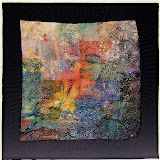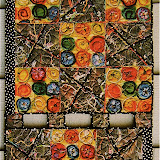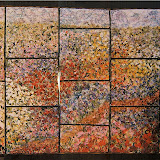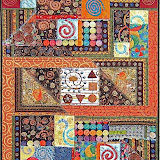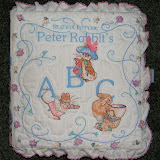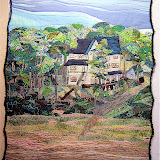Here is another "doll". She is the result of a challenge. Seven of us each brought a piece of fabric that we thought was interesting or difficult to use. There was a large scale print of green limes, a red machine-made lace, a smudged mis-printed piece, a primary color striped white fabric, a muted red-violet oriental wave print, and I contributed a hand-dyed red wool. We gave ourselves a year to think of a way to use these "somehow". There were no rules imposed. I chose to use mine all in one piece.

"Waiting in New Orleans" - 19"x24" - 2003
She is not a "red hat" lady ... she's a bit too young. I based this piece on a painting I had seen in a Boulder, Colorado gallery. Tom Barnes features "long neck ladies" wearing huge red hats decorated with a single oversized blossom in a water color series. Here is a photo of one of his paintings from the gallery postcard.

"Madam Ste. Ursule" - 32"x32"
I fell in love with his paintings, but certainly could not afford to buy one. I "played" with one for this challenge. There was a role for each of the fabrics ... plus. I chopped up several silk flowers to make the blossom. The background is a flanel with ikat-like white lines shot throughout. Her skin is unbleached muslin and her lips are a red silk brocade. I used oil stick pastels for shading her alabaster skin tone and the blossom.

Even though the red wool was wonderful, I layered wool roving over it to give highlights and shadows to her hat and gloves. The roving was also used to soften and shade the fabric of her dress. Making a glass of wine that looked convincing amazed me. Oil stick pastel is used to give highlights to the glass and reflected colors in the wine.

This is a fabric collage layered under black tulle. The black outlines are a straight stitch with a heavy thread. That stitching is also the quilting for this piece.
I devised a unique framing technique for this wall quilt. A piece of foam core was cut. The inner opening of the foam core mat ends at the outer black line on the border. A thin batting was glued onto the front surface of the foam core with spray adhesive.

The quilted piece was bordered in the usual way (note the primary striped white fabric was overpainted with a diluted black and forms the inner border around the piece). The backing fabric was sewn to the quilted and bordered front piece pillowcase style, leaving one end open. The foam core frame was slid inside and the open end slip-stitched shut. I carefully machine couched black chenile yarn at the inside edge of the foam core frame as well as between the striped and dark borders. If the piece were any larger, doing this machine stitching with the foam core inside the piece would be impossible because of the limited space in the harp area of the sewing machine.
Here's a photo of the backside. The hanging device is hand sewn in place. You can see the zig-zag stitches of the two couched seams.

This piece has a permanent hanging space in our living room. It hasn't been entered in any shows because it so closely resembles the painting even though the scale is much smaller and the medium is different. I made it for me.
 Sweet Gold - 9"x4"- 2004
Sweet Gold - 9"x4"- 2004 The pears and grapes are shaded with oil stick pastels. The white highlights are paint. The butterflies and flowers are also enhanced with pastels.
The pears and grapes are shaded with oil stick pastels. The white highlights are paint. The butterflies and flowers are also enhanced with pastels. This is where the pair of those miniature quilts hang.
This is where the pair of those miniature quilts hang. This area features a collection of chickens. I find it amusing that I really dislike real chickens, but I very much like chicken art. My negative feelings stem from living with and caring for and plucking those stupid birds on the farm in Iowa.
This area features a collection of chickens. I find it amusing that I really dislike real chickens, but I very much like chicken art. My negative feelings stem from living with and caring for and plucking those stupid birds on the farm in Iowa. My Carol Bryer Fallet tea cozy lives in this cupboard. It covers the clear glass teapot.
My Carol Bryer Fallet tea cozy lives in this cupboard. It covers the clear glass teapot. I'm especially fond of this cozy, comfortable corner in the kitchen. It's a nice place to enjoy a spot of tea with a friend. The first scrap quilt I made is hanging over the back of a chair.
I'm especially fond of this cozy, comfortable corner in the kitchen. It's a nice place to enjoy a spot of tea with a friend. The first scrap quilt I made is hanging over the back of a chair. We have a permanent guest, Bertha Big Body, who occupies this corner of my cozy corner. The painting of the chef with the chicken was made by my husband when he was 11 1/2 years old. He did the wood burning of Toulouse Lautrec about 40 years ago.
We have a permanent guest, Bertha Big Body, who occupies this corner of my cozy corner. The painting of the chef with the chicken was made by my husband when he was 11 1/2 years old. He did the wood burning of Toulouse Lautrec about 40 years ago. As you can see, our kitchen is full of art. There's a 4' tall wooden banana tree standing in the middle of the island. Of course there's Elvis as well as one of my favorite chickens. Really, there is space to work and room to eat here.
As you can see, our kitchen is full of art. There's a 4' tall wooden banana tree standing in the middle of the island. Of course there's Elvis as well as one of my favorite chickens. Really, there is space to work and room to eat here.






























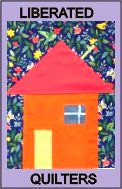 Fabric Bird Sculpture Pattern
Fabric Bird Sculpture Pattern




